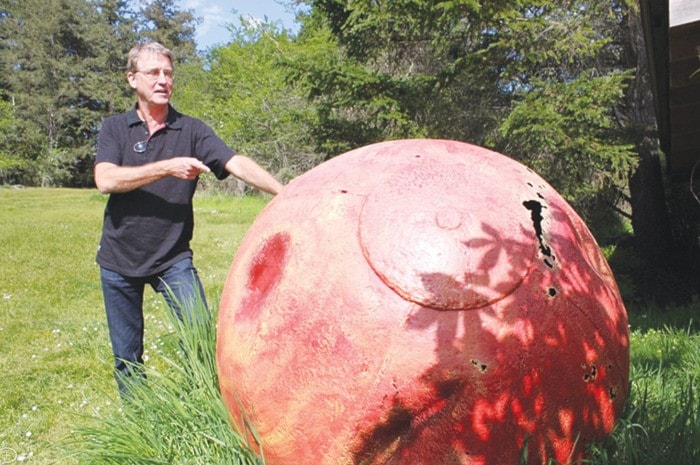Took a trip to the centre of our universe today… Well, that’s a bit of an exaggeration. Actually, my modest enterprise was a Journey Through the Solar System to the surface of the sun, an adventure of much more modest proportions, and something manageable on a post publication-day afternoon, when there’s a lull in the calendar of weekly newspaper routines, allowing for extraterrestrial expeditions of this sort.
Lest you are concerned for my safety, or sanity, or both, let me assure you, this trip is entirely feasible for just about anyone, entailing no more risk than driving from the Chronicle office on Oyster Bay Drive, or wherever you happen to be, out to the Yellow Point Lodge in Cedar (call 250-245-7422 first or stop in at the office when you arrive, if you’re planning to go into close orbit around the sun, or Yellow Point owner Richard Hill might intercept you en route.)
There’s even a brochure, produced by Hill, of this interplanetary expedition. It gives precise coordinates for planets you will be passing on the way in: Pluto, Neptune, Uranus, Saturn, Jupiter, Mars, Earth, Venus, Mercury and finally – just a few paces from the lodge lobby – the Sun, which is actually an old mooring buoy that has been on the Yellow Point Lodge grounds for 65 years.
From there the edge of our solar system is located at Cedar and Yellow Point Roads, in the Chuckwagon Market. That’s where you’ll find Pluto, described in the Journey Through the Solar System brochure as ‘a minor planet.’
Minor is, of course, a relative term, and anyone brought up in the era of Star Trek or 2001 A Space Odyssey, would surely expect something grand looming in the cockpit window, accompanied by stirring Music of the Spheres booming through Hi-fi speakers. After all, the real Pluto has a diameter of 2,390 kilometres – about one-sixth the earth’s – and an orbit of 90,558 days, compared to the earth’s paltry 365.
Docking Space Ship Neon in the Chuchwagon parking lot, I followed the brochure directions to the most distant planet in our solar system, which could be found “at the back of the store, left of the vegetables.” What came into view astounded me. It was globe not much bigger than a frozen pea, perched on a metal stand like a golf ball waiting to be smacked for a long-drive.
If your mind isn’t boggling, remember, that little pea would be in orbit around our mooring buoy sun located about 5.87 kilometres away - a trip that would take just under three-quarters of an hour at the speed of light, if our miniature Pluto and its orbit were scaled up a billion times – to the actual dimensions of our solar system…
And that’s the whole point of the Journey Through the Solar System experience Hill has staked out; shrink things down to a scale people can take in and marvel at, then really blow their minds by telling them to multiply their picture times a billion. The real Pluto can be found 5.87 billion kilometres from the surface of the sun at one point in its elliptical orbit.
So let’s ‘beam up’ to a perspective drivers can understand. The SS Neon might chug along through earth’s atmosphere for 587,000 kilometres; that means I would go through 10,000 Neons getting from Pluto to the surface of the Sun – that’s 10,000 NLEUs (Neon Life Expectancy Units). Driving a Neon through one NLEU at an average speed of 100 kilometres per hour would require 5,870 hours; 10,000 NLEUs would eat up 58.7 million hours, which translates into a tad over 6,690 years of driving, without stopping once for coffee and a donut.
That’s the scale the Journey Through the Solar System allows us to imagine.
Hill dreamed up the project after a visit to the Mauna Kea Observatory in Hawaii, where he bought a marble-sized version of the earth in the gift shop. He wondered on his return what size the earth would be if the sun was shrunk to the size of the mooring buoy at Yellow Point, about 1.2 metres (or four feet) in diameter. Turns out his marble-sized earth was about twice as big as it should have been.
From there, Hill calculated the sizes and distances of all the planets, and with the help of a bequest from a family friend John MacDonald, ‘hand-crafted planets’ by Jo and Vic Duffhues of JoVic Pottery, and planet stands by John Schwarze (Schwarze Fab in Nanaimo), the solar system unfolded as it should, with Pluto in the Chuckwagon Market and all the other planets in between. “Everything is accurately scaled for size and distance,” Hill explained.
And just in case you think you’re really getting a handle on the scale of things interplanetary, the brochure ads, “Our sun is a mid-sized, middle aged star among hundreds of billions in our galaxy, the Milky Way. There are roughly 100 billion known galaxies.”
But, hey, if we can get our heads around one solar system with the help of a model like the Journey Through the Solar System, perhaps that’s enough. At the very least it will give us an appreciation for just how special this teeny ball of rock, dirt, water and air we call the Earth really is.
“Absolutely every living thing we have proof about, every thing that’s ever lived that we know about for sure, all lives on this little dot right here,” Hill said, pointing to the half-sized marble earth near the tennis courts out at Yellow Point Lodge.
